Consumer Behavior and Decision Making in the Hospitality Sector
VerifiedAdded on 2023/01/17
|10
|3381
|22
Report
AI Summary
This report provides a comprehensive analysis of consumer behaviour within the hospitality industry. It begins by defining consumer behaviour and examining the cultural, social, personal, and psychological factors that influence consumer attitudes and purchase decisions. The report then explores the impact of digital technology on consumer trends, highlighting changes in how consumers interact with hospitality businesses. A significant portion of the report is dedicated to mapping the consumer decision-making journey, including the stages of problem recognition, information search, evaluation of alternatives, purchase decision, and post-purchase behaviour. The importance of path-to-purchase mapping for marketers and the role of heuristics and new technologies in influencing consumer choices are also discussed. Furthermore, the report differentiates between B2B and B2C decision-making processes in the hospitality sector and outlines various market research approaches and methods used to understand consumer behaviour. Finally, it evaluates how marketers can influence the different stages of the hospitality consumer decision-making process. The report is based on an assignment completed for a Higher National Certificate (HNC) in Hospitality Management and is contributed by a student to Desklib, a platform offering AI-powered study tools.
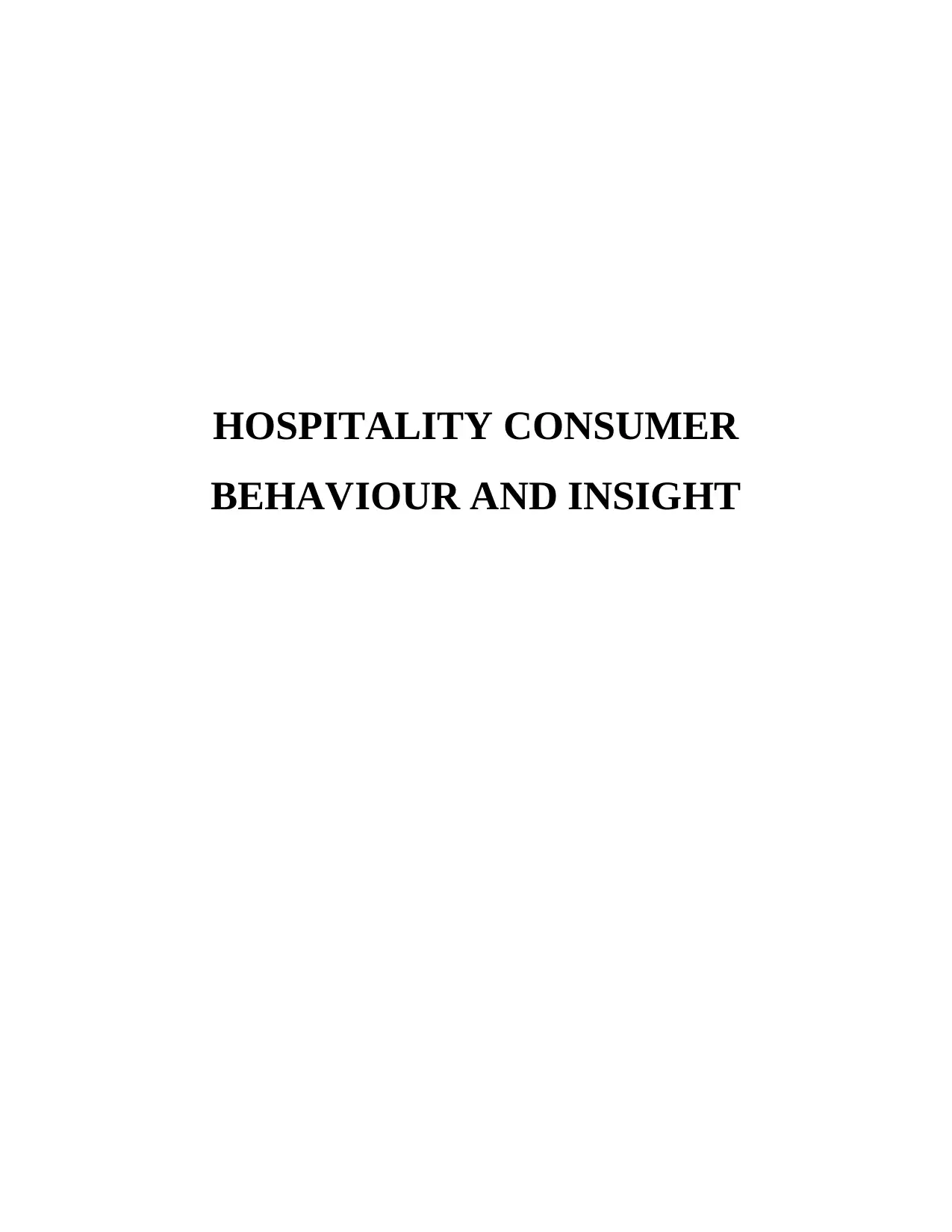
HOSPITALITY CONSUMER
BEHAVIOUR AND INSIGHT
BEHAVIOUR AND INSIGHT
Paraphrase This Document
Need a fresh take? Get an instant paraphrase of this document with our AI Paraphraser
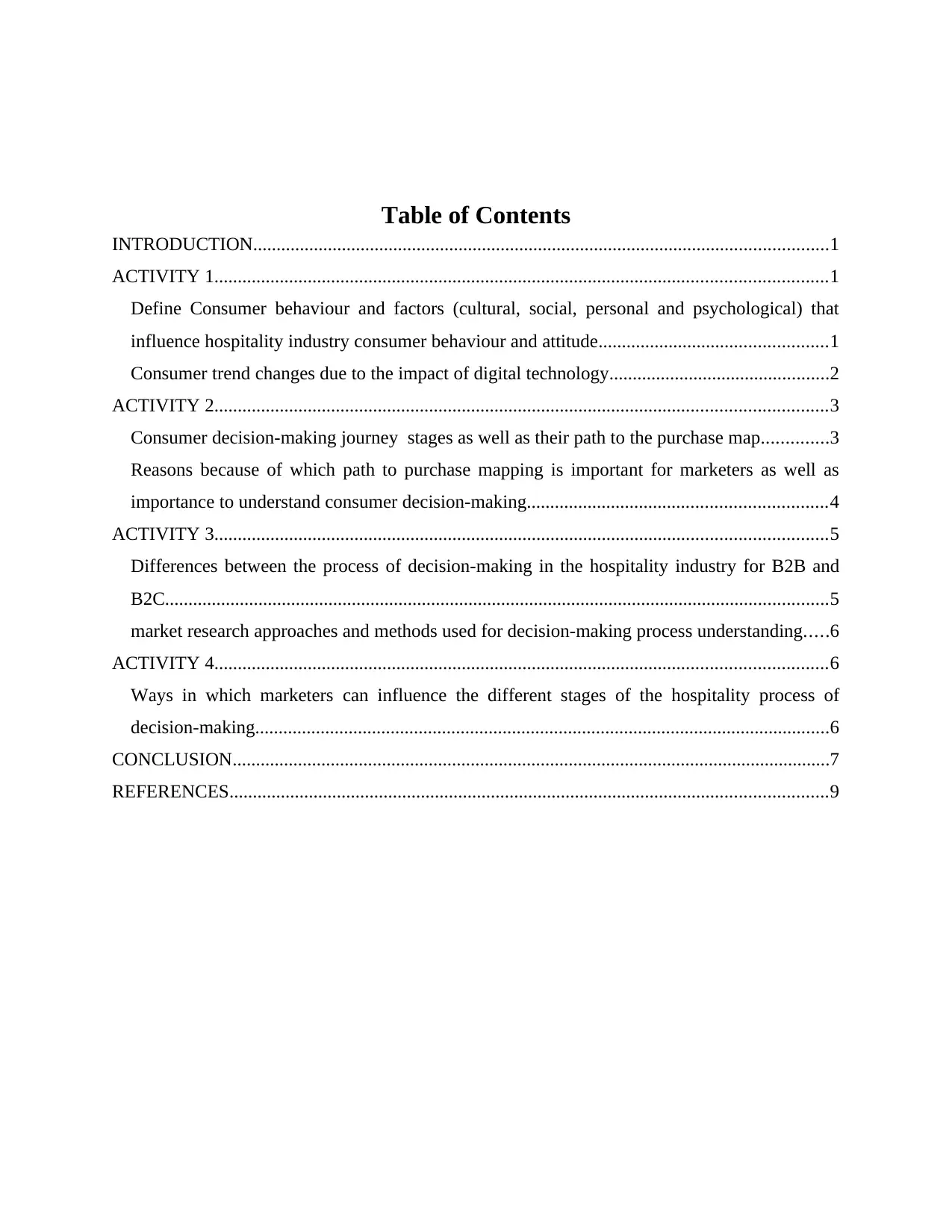
Table of Contents
INTRODUCTION...........................................................................................................................1
ACTIVITY 1...................................................................................................................................1
Define Consumer behaviour and factors (cultural, social, personal and psychological) that
influence hospitality industry consumer behaviour and attitude.................................................1
Consumer trend changes due to the impact of digital technology...............................................2
ACTIVITY 2...................................................................................................................................3
Consumer decision-making journey stages as well as their path to the purchase map..............3
Reasons because of which path to purchase mapping is important for marketers as well as
importance to understand consumer decision-making................................................................4
ACTIVITY 3...................................................................................................................................5
Differences between the process of decision-making in the hospitality industry for B2B and
B2C..............................................................................................................................................5
market research approaches and methods used for decision-making process understanding.....6
ACTIVITY 4...................................................................................................................................6
Ways in which marketers can influence the different stages of the hospitality process of
decision-making...........................................................................................................................6
CONCLUSION................................................................................................................................7
REFERENCES................................................................................................................................9
INTRODUCTION...........................................................................................................................1
ACTIVITY 1...................................................................................................................................1
Define Consumer behaviour and factors (cultural, social, personal and psychological) that
influence hospitality industry consumer behaviour and attitude.................................................1
Consumer trend changes due to the impact of digital technology...............................................2
ACTIVITY 2...................................................................................................................................3
Consumer decision-making journey stages as well as their path to the purchase map..............3
Reasons because of which path to purchase mapping is important for marketers as well as
importance to understand consumer decision-making................................................................4
ACTIVITY 3...................................................................................................................................5
Differences between the process of decision-making in the hospitality industry for B2B and
B2C..............................................................................................................................................5
market research approaches and methods used for decision-making process understanding.....6
ACTIVITY 4...................................................................................................................................6
Ways in which marketers can influence the different stages of the hospitality process of
decision-making...........................................................................................................................6
CONCLUSION................................................................................................................................7
REFERENCES................................................................................................................................9
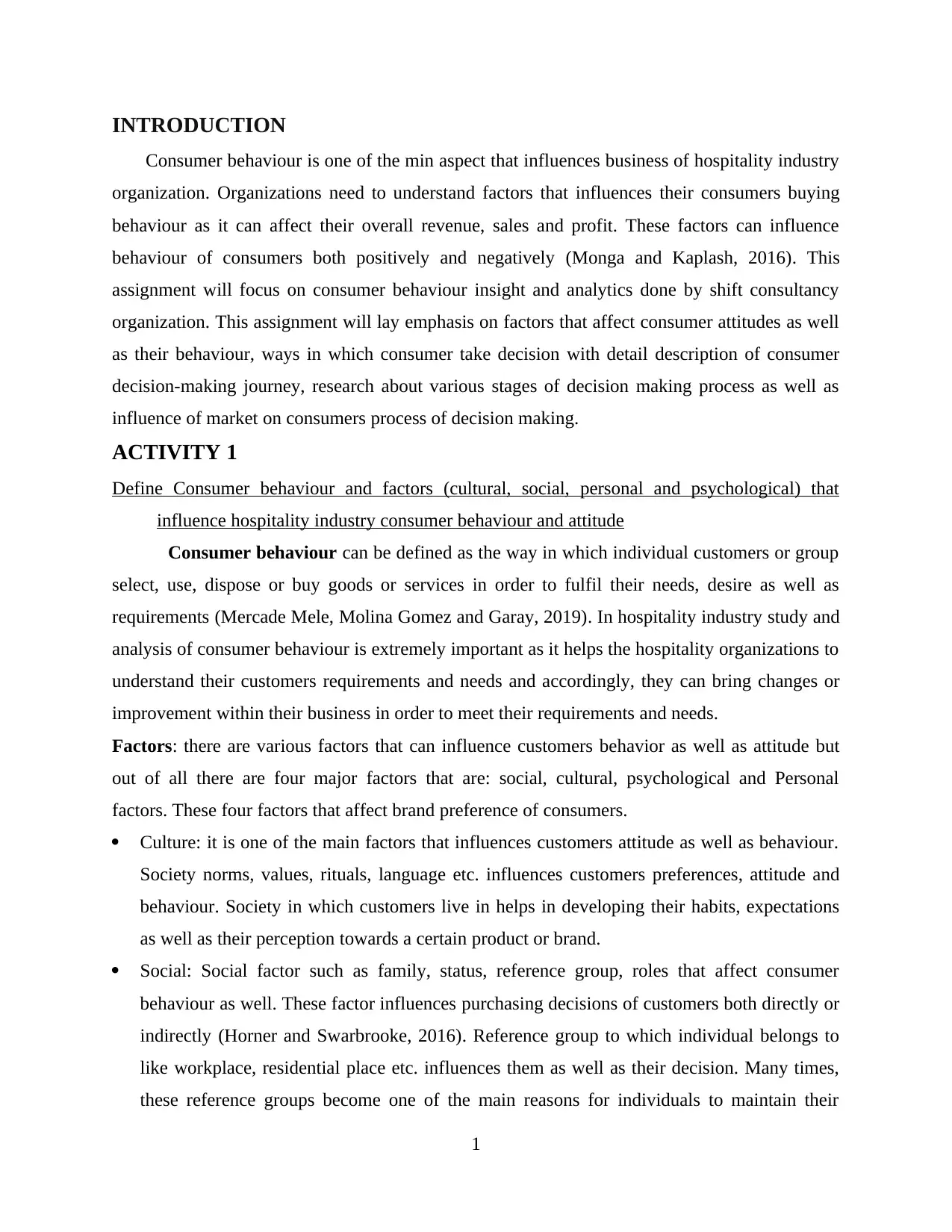
INTRODUCTION
Consumer behaviour is one of the min aspect that influences business of hospitality industry
organization. Organizations need to understand factors that influences their consumers buying
behaviour as it can affect their overall revenue, sales and profit. These factors can influence
behaviour of consumers both positively and negatively (Monga and Kaplash, 2016). This
assignment will focus on consumer behaviour insight and analytics done by shift consultancy
organization. This assignment will lay emphasis on factors that affect consumer attitudes as well
as their behaviour, ways in which consumer take decision with detail description of consumer
decision-making journey, research about various stages of decision making process as well as
influence of market on consumers process of decision making.
ACTIVITY 1
Define Consumer behaviour and factors (cultural, social, personal and psychological) that
influence hospitality industry consumer behaviour and attitude
Consumer behaviour can be defined as the way in which individual customers or group
select, use, dispose or buy goods or services in order to fulfil their needs, desire as well as
requirements (Mercade Mele, Molina Gomez and Garay, 2019). In hospitality industry study and
analysis of consumer behaviour is extremely important as it helps the hospitality organizations to
understand their customers requirements and needs and accordingly, they can bring changes or
improvement within their business in order to meet their requirements and needs.
Factors: there are various factors that can influence customers behavior as well as attitude but
out of all there are four major factors that are: social, cultural, psychological and Personal
factors. These four factors that affect brand preference of consumers.
Culture: it is one of the main factors that influences customers attitude as well as behaviour.
Society norms, values, rituals, language etc. influences customers preferences, attitude and
behaviour. Society in which customers live in helps in developing their habits, expectations
as well as their perception towards a certain product or brand.
Social: Social factor such as family, status, reference group, roles that affect consumer
behaviour as well. These factor influences purchasing decisions of customers both directly or
indirectly (Horner and Swarbrooke, 2016). Reference group to which individual belongs to
like workplace, residential place etc. influences them as well as their decision. Many times,
these reference groups become one of the main reasons for individuals to maintain their
1
Consumer behaviour is one of the min aspect that influences business of hospitality industry
organization. Organizations need to understand factors that influences their consumers buying
behaviour as it can affect their overall revenue, sales and profit. These factors can influence
behaviour of consumers both positively and negatively (Monga and Kaplash, 2016). This
assignment will focus on consumer behaviour insight and analytics done by shift consultancy
organization. This assignment will lay emphasis on factors that affect consumer attitudes as well
as their behaviour, ways in which consumer take decision with detail description of consumer
decision-making journey, research about various stages of decision making process as well as
influence of market on consumers process of decision making.
ACTIVITY 1
Define Consumer behaviour and factors (cultural, social, personal and psychological) that
influence hospitality industry consumer behaviour and attitude
Consumer behaviour can be defined as the way in which individual customers or group
select, use, dispose or buy goods or services in order to fulfil their needs, desire as well as
requirements (Mercade Mele, Molina Gomez and Garay, 2019). In hospitality industry study and
analysis of consumer behaviour is extremely important as it helps the hospitality organizations to
understand their customers requirements and needs and accordingly, they can bring changes or
improvement within their business in order to meet their requirements and needs.
Factors: there are various factors that can influence customers behavior as well as attitude but
out of all there are four major factors that are: social, cultural, psychological and Personal
factors. These four factors that affect brand preference of consumers.
Culture: it is one of the main factors that influences customers attitude as well as behaviour.
Society norms, values, rituals, language etc. influences customers preferences, attitude and
behaviour. Society in which customers live in helps in developing their habits, expectations
as well as their perception towards a certain product or brand.
Social: Social factor such as family, status, reference group, roles that affect consumer
behaviour as well. These factor influences purchasing decisions of customers both directly or
indirectly (Horner and Swarbrooke, 2016). Reference group to which individual belongs to
like workplace, residential place etc. influences them as well as their decision. Many times,
these reference groups become one of the main reasons for individuals to maintain their
1
⊘ This is a preview!⊘
Do you want full access?
Subscribe today to unlock all pages.

Trusted by 1+ million students worldwide
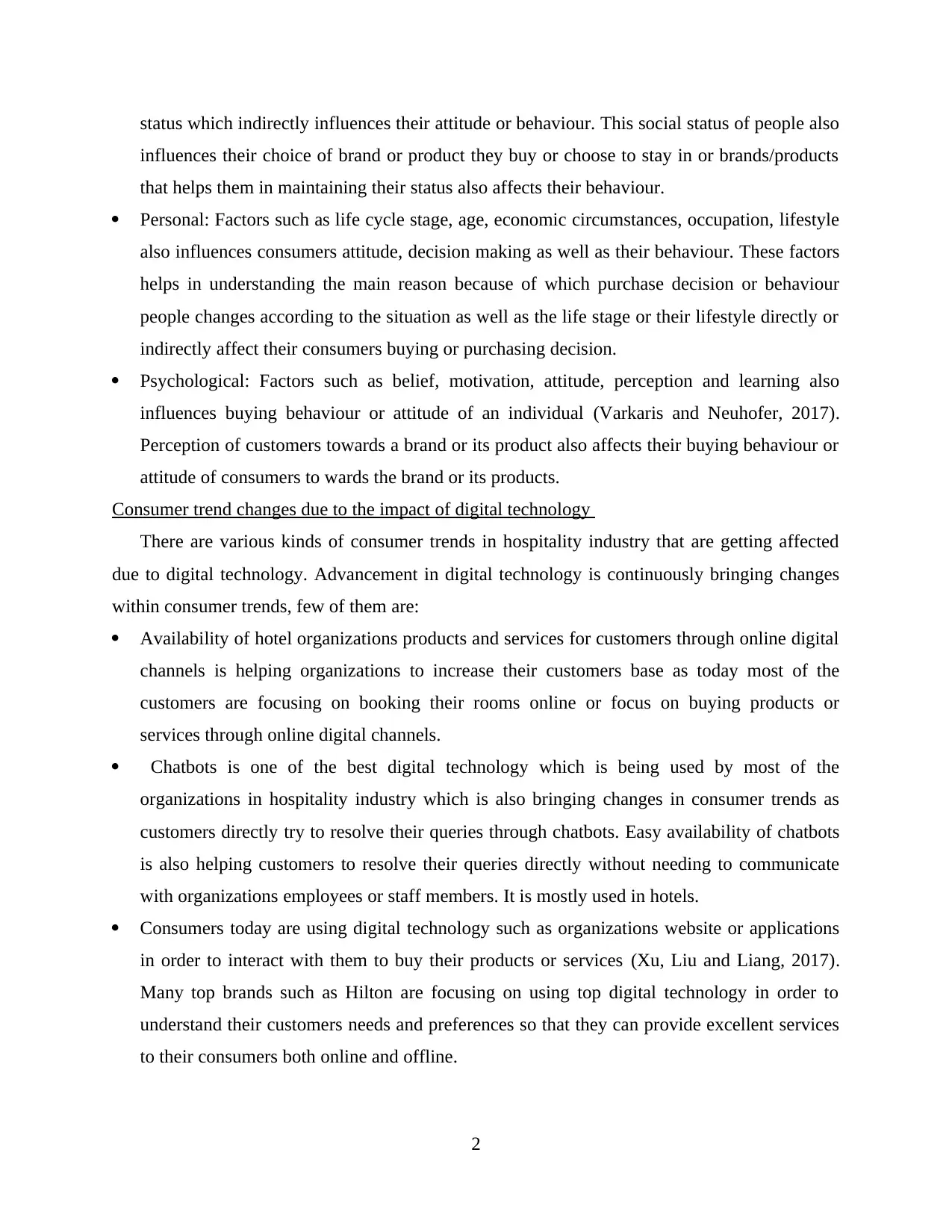
status which indirectly influences their attitude or behaviour. This social status of people also
influences their choice of brand or product they buy or choose to stay in or brands/products
that helps them in maintaining their status also affects their behaviour.
Personal: Factors such as life cycle stage, age, economic circumstances, occupation, lifestyle
also influences consumers attitude, decision making as well as their behaviour. These factors
helps in understanding the main reason because of which purchase decision or behaviour
people changes according to the situation as well as the life stage or their lifestyle directly or
indirectly affect their consumers buying or purchasing decision.
Psychological: Factors such as belief, motivation, attitude, perception and learning also
influences buying behaviour or attitude of an individual (Varkaris and Neuhofer, 2017).
Perception of customers towards a brand or its product also affects their buying behaviour or
attitude of consumers to wards the brand or its products.
Consumer trend changes due to the impact of digital technology
There are various kinds of consumer trends in hospitality industry that are getting affected
due to digital technology. Advancement in digital technology is continuously bringing changes
within consumer trends, few of them are:
Availability of hotel organizations products and services for customers through online digital
channels is helping organizations to increase their customers base as today most of the
customers are focusing on booking their rooms online or focus on buying products or
services through online digital channels.
Chatbots is one of the best digital technology which is being used by most of the
organizations in hospitality industry which is also bringing changes in consumer trends as
customers directly try to resolve their queries through chatbots. Easy availability of chatbots
is also helping customers to resolve their queries directly without needing to communicate
with organizations employees or staff members. It is mostly used in hotels.
Consumers today are using digital technology such as organizations website or applications
in order to interact with them to buy their products or services (Xu, Liu and Liang, 2017).
Many top brands such as Hilton are focusing on using top digital technology in order to
understand their customers needs and preferences so that they can provide excellent services
to their consumers both online and offline.
2
influences their choice of brand or product they buy or choose to stay in or brands/products
that helps them in maintaining their status also affects their behaviour.
Personal: Factors such as life cycle stage, age, economic circumstances, occupation, lifestyle
also influences consumers attitude, decision making as well as their behaviour. These factors
helps in understanding the main reason because of which purchase decision or behaviour
people changes according to the situation as well as the life stage or their lifestyle directly or
indirectly affect their consumers buying or purchasing decision.
Psychological: Factors such as belief, motivation, attitude, perception and learning also
influences buying behaviour or attitude of an individual (Varkaris and Neuhofer, 2017).
Perception of customers towards a brand or its product also affects their buying behaviour or
attitude of consumers to wards the brand or its products.
Consumer trend changes due to the impact of digital technology
There are various kinds of consumer trends in hospitality industry that are getting affected
due to digital technology. Advancement in digital technology is continuously bringing changes
within consumer trends, few of them are:
Availability of hotel organizations products and services for customers through online digital
channels is helping organizations to increase their customers base as today most of the
customers are focusing on booking their rooms online or focus on buying products or
services through online digital channels.
Chatbots is one of the best digital technology which is being used by most of the
organizations in hospitality industry which is also bringing changes in consumer trends as
customers directly try to resolve their queries through chatbots. Easy availability of chatbots
is also helping customers to resolve their queries directly without needing to communicate
with organizations employees or staff members. It is mostly used in hotels.
Consumers today are using digital technology such as organizations website or applications
in order to interact with them to buy their products or services (Xu, Liu and Liang, 2017).
Many top brands such as Hilton are focusing on using top digital technology in order to
understand their customers needs and preferences so that they can provide excellent services
to their consumers both online and offline.
2
Paraphrase This Document
Need a fresh take? Get an instant paraphrase of this document with our AI Paraphraser
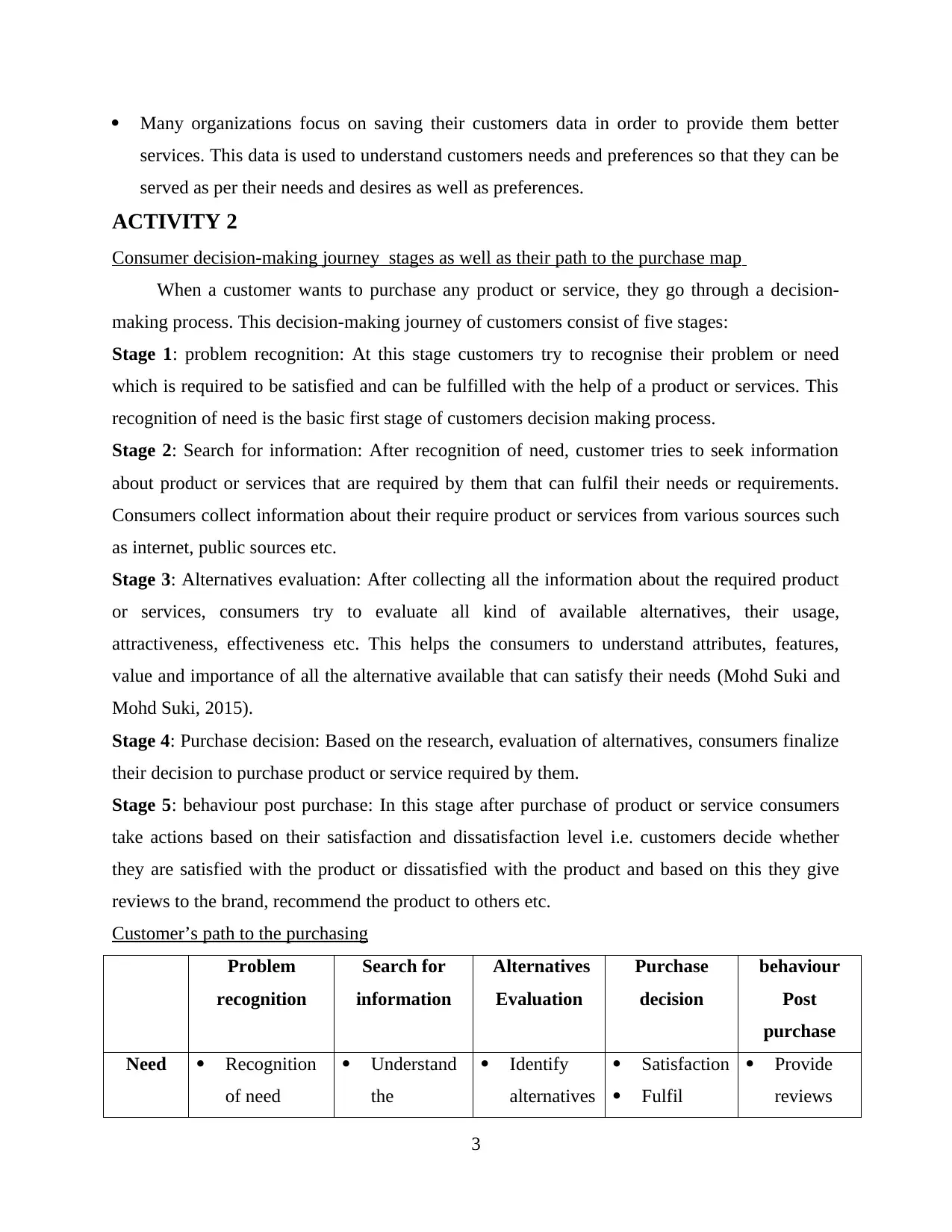
Many organizations focus on saving their customers data in order to provide them better
services. This data is used to understand customers needs and preferences so that they can be
served as per their needs and desires as well as preferences.
ACTIVITY 2
Consumer decision-making journey stages as well as their path to the purchase map
When a customer wants to purchase any product or service, they go through a decision-
making process. This decision-making journey of customers consist of five stages:
Stage 1: problem recognition: At this stage customers try to recognise their problem or need
which is required to be satisfied and can be fulfilled with the help of a product or services. This
recognition of need is the basic first stage of customers decision making process.
Stage 2: Search for information: After recognition of need, customer tries to seek information
about product or services that are required by them that can fulfil their needs or requirements.
Consumers collect information about their require product or services from various sources such
as internet, public sources etc.
Stage 3: Alternatives evaluation: After collecting all the information about the required product
or services, consumers try to evaluate all kind of available alternatives, their usage,
attractiveness, effectiveness etc. This helps the consumers to understand attributes, features,
value and importance of all the alternative available that can satisfy their needs (Mohd Suki and
Mohd Suki, 2015).
Stage 4: Purchase decision: Based on the research, evaluation of alternatives, consumers finalize
their decision to purchase product or service required by them.
Stage 5: behaviour post purchase: In this stage after purchase of product or service consumers
take actions based on their satisfaction and dissatisfaction level i.e. customers decide whether
they are satisfied with the product or dissatisfied with the product and based on this they give
reviews to the brand, recommend the product to others etc.
Customer’s path to the purchasing
Problem
recognition
Search for
information
Alternatives
Evaluation
Purchase
decision
behaviour
Post
purchase
Need Recognition
of need
Understand
the
Identify
alternatives
Satisfaction
Fulfil
Provide
reviews
3
services. This data is used to understand customers needs and preferences so that they can be
served as per their needs and desires as well as preferences.
ACTIVITY 2
Consumer decision-making journey stages as well as their path to the purchase map
When a customer wants to purchase any product or service, they go through a decision-
making process. This decision-making journey of customers consist of five stages:
Stage 1: problem recognition: At this stage customers try to recognise their problem or need
which is required to be satisfied and can be fulfilled with the help of a product or services. This
recognition of need is the basic first stage of customers decision making process.
Stage 2: Search for information: After recognition of need, customer tries to seek information
about product or services that are required by them that can fulfil their needs or requirements.
Consumers collect information about their require product or services from various sources such
as internet, public sources etc.
Stage 3: Alternatives evaluation: After collecting all the information about the required product
or services, consumers try to evaluate all kind of available alternatives, their usage,
attractiveness, effectiveness etc. This helps the consumers to understand attributes, features,
value and importance of all the alternative available that can satisfy their needs (Mohd Suki and
Mohd Suki, 2015).
Stage 4: Purchase decision: Based on the research, evaluation of alternatives, consumers finalize
their decision to purchase product or service required by them.
Stage 5: behaviour post purchase: In this stage after purchase of product or service consumers
take actions based on their satisfaction and dissatisfaction level i.e. customers decide whether
they are satisfied with the product or dissatisfied with the product and based on this they give
reviews to the brand, recommend the product to others etc.
Customer’s path to the purchasing
Problem
recognition
Search for
information
Alternatives
Evaluation
Purchase
decision
behaviour
Post
purchase
Need Recognition
of need
Understand
the
Identify
alternatives
Satisfaction
Fulfil
Provide
reviews
3
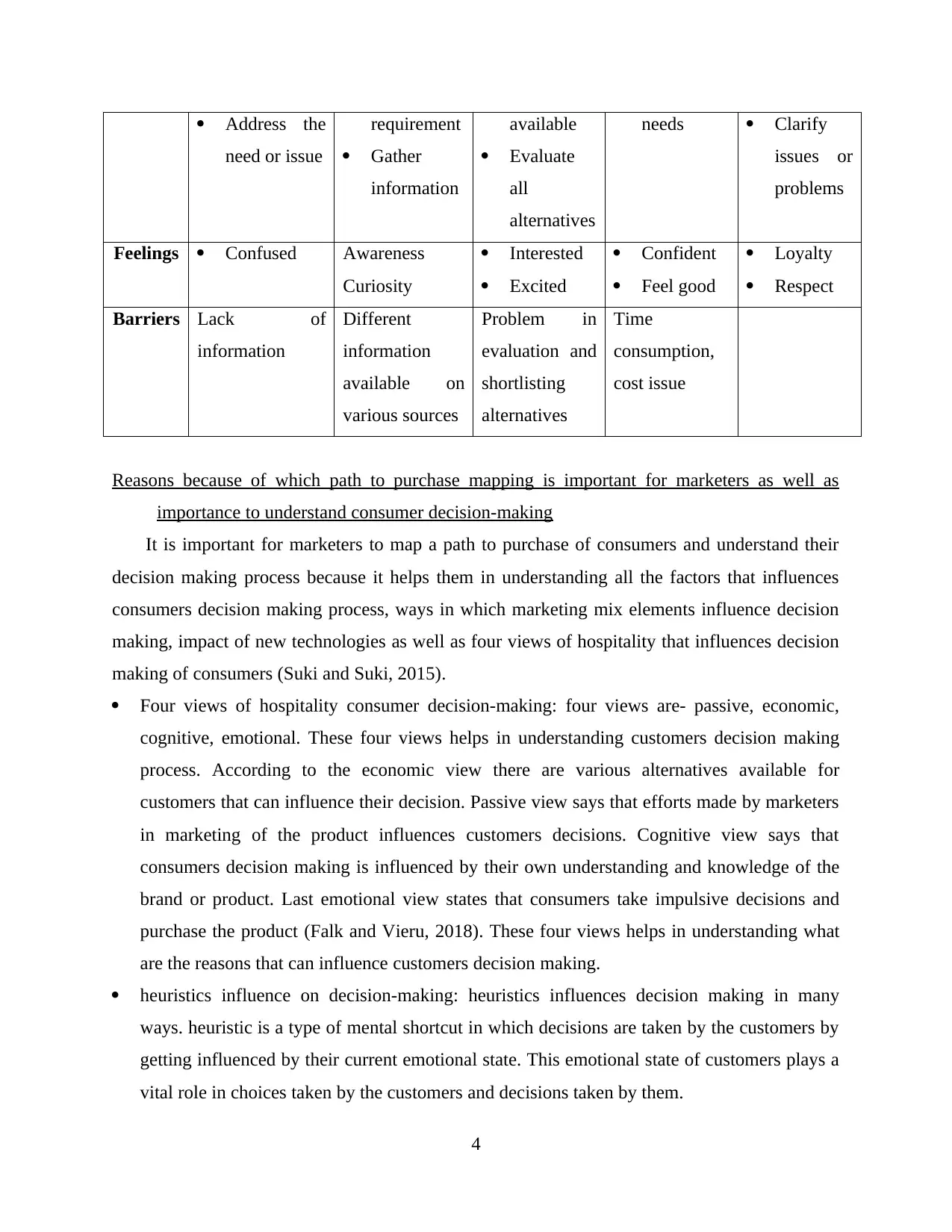
Address the
need or issue
requirement
Gather
information
available
Evaluate
all
alternatives
needs Clarify
issues or
problems
Feelings Confused Awareness
Curiosity
Interested
Excited
Confident
Feel good
Loyalty
Respect
Barriers Lack of
information
Different
information
available on
various sources
Problem in
evaluation and
shortlisting
alternatives
Time
consumption,
cost issue
Reasons because of which path to purchase mapping is important for marketers as well as
importance to understand consumer decision-making
It is important for marketers to map a path to purchase of consumers and understand their
decision making process because it helps them in understanding all the factors that influences
consumers decision making process, ways in which marketing mix elements influence decision
making, impact of new technologies as well as four views of hospitality that influences decision
making of consumers (Suki and Suki, 2015).
Four views of hospitality consumer decision-making: four views are- passive, economic,
cognitive, emotional. These four views helps in understanding customers decision making
process. According to the economic view there are various alternatives available for
customers that can influence their decision. Passive view says that efforts made by marketers
in marketing of the product influences customers decisions. Cognitive view says that
consumers decision making is influenced by their own understanding and knowledge of the
brand or product. Last emotional view states that consumers take impulsive decisions and
purchase the product (Falk and Vieru, 2018). These four views helps in understanding what
are the reasons that can influence customers decision making.
heuristics influence on decision-making: heuristics influences decision making in many
ways. heuristic is a type of mental shortcut in which decisions are taken by the customers by
getting influenced by their current emotional state. This emotional state of customers plays a
vital role in choices taken by the customers and decisions taken by them.
4
need or issue
requirement
Gather
information
available
Evaluate
all
alternatives
needs Clarify
issues or
problems
Feelings Confused Awareness
Curiosity
Interested
Excited
Confident
Feel good
Loyalty
Respect
Barriers Lack of
information
Different
information
available on
various sources
Problem in
evaluation and
shortlisting
alternatives
Time
consumption,
cost issue
Reasons because of which path to purchase mapping is important for marketers as well as
importance to understand consumer decision-making
It is important for marketers to map a path to purchase of consumers and understand their
decision making process because it helps them in understanding all the factors that influences
consumers decision making process, ways in which marketing mix elements influence decision
making, impact of new technologies as well as four views of hospitality that influences decision
making of consumers (Suki and Suki, 2015).
Four views of hospitality consumer decision-making: four views are- passive, economic,
cognitive, emotional. These four views helps in understanding customers decision making
process. According to the economic view there are various alternatives available for
customers that can influence their decision. Passive view says that efforts made by marketers
in marketing of the product influences customers decisions. Cognitive view says that
consumers decision making is influenced by their own understanding and knowledge of the
brand or product. Last emotional view states that consumers take impulsive decisions and
purchase the product (Falk and Vieru, 2018). These four views helps in understanding what
are the reasons that can influence customers decision making.
heuristics influence on decision-making: heuristics influences decision making in many
ways. heuristic is a type of mental shortcut in which decisions are taken by the customers by
getting influenced by their current emotional state. This emotional state of customers plays a
vital role in choices taken by the customers and decisions taken by them.
4
⊘ This is a preview!⊘
Do you want full access?
Subscribe today to unlock all pages.

Trusted by 1+ million students worldwide
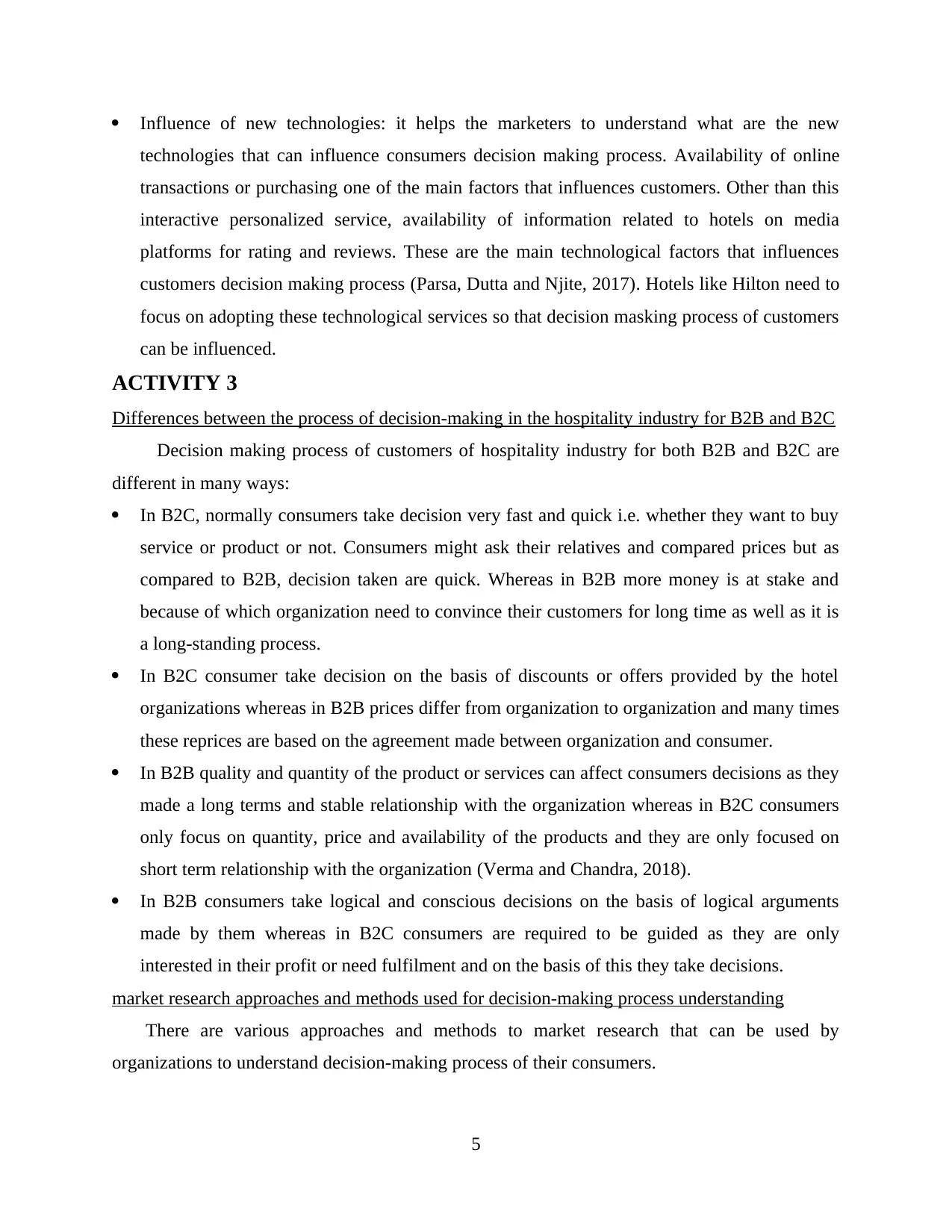
Influence of new technologies: it helps the marketers to understand what are the new
technologies that can influence consumers decision making process. Availability of online
transactions or purchasing one of the main factors that influences customers. Other than this
interactive personalized service, availability of information related to hotels on media
platforms for rating and reviews. These are the main technological factors that influences
customers decision making process (Parsa, Dutta and Njite, 2017). Hotels like Hilton need to
focus on adopting these technological services so that decision masking process of customers
can be influenced.
ACTIVITY 3
Differences between the process of decision-making in the hospitality industry for B2B and B2C
Decision making process of customers of hospitality industry for both B2B and B2C are
different in many ways:
In B2C, normally consumers take decision very fast and quick i.e. whether they want to buy
service or product or not. Consumers might ask their relatives and compared prices but as
compared to B2B, decision taken are quick. Whereas in B2B more money is at stake and
because of which organization need to convince their customers for long time as well as it is
a long-standing process.
In B2C consumer take decision on the basis of discounts or offers provided by the hotel
organizations whereas in B2B prices differ from organization to organization and many times
these reprices are based on the agreement made between organization and consumer.
In B2B quality and quantity of the product or services can affect consumers decisions as they
made a long terms and stable relationship with the organization whereas in B2C consumers
only focus on quantity, price and availability of the products and they are only focused on
short term relationship with the organization (Verma and Chandra, 2018).
In B2B consumers take logical and conscious decisions on the basis of logical arguments
made by them whereas in B2C consumers are required to be guided as they are only
interested in their profit or need fulfilment and on the basis of this they take decisions.
market research approaches and methods used for decision-making process understanding
There are various approaches and methods to market research that can be used by
organizations to understand decision-making process of their consumers.
5
technologies that can influence consumers decision making process. Availability of online
transactions or purchasing one of the main factors that influences customers. Other than this
interactive personalized service, availability of information related to hotels on media
platforms for rating and reviews. These are the main technological factors that influences
customers decision making process (Parsa, Dutta and Njite, 2017). Hotels like Hilton need to
focus on adopting these technological services so that decision masking process of customers
can be influenced.
ACTIVITY 3
Differences between the process of decision-making in the hospitality industry for B2B and B2C
Decision making process of customers of hospitality industry for both B2B and B2C are
different in many ways:
In B2C, normally consumers take decision very fast and quick i.e. whether they want to buy
service or product or not. Consumers might ask their relatives and compared prices but as
compared to B2B, decision taken are quick. Whereas in B2B more money is at stake and
because of which organization need to convince their customers for long time as well as it is
a long-standing process.
In B2C consumer take decision on the basis of discounts or offers provided by the hotel
organizations whereas in B2B prices differ from organization to organization and many times
these reprices are based on the agreement made between organization and consumer.
In B2B quality and quantity of the product or services can affect consumers decisions as they
made a long terms and stable relationship with the organization whereas in B2C consumers
only focus on quantity, price and availability of the products and they are only focused on
short term relationship with the organization (Verma and Chandra, 2018).
In B2B consumers take logical and conscious decisions on the basis of logical arguments
made by them whereas in B2C consumers are required to be guided as they are only
interested in their profit or need fulfilment and on the basis of this they take decisions.
market research approaches and methods used for decision-making process understanding
There are various approaches and methods to market research that can be used by
organizations to understand decision-making process of their consumers.
5
Paraphrase This Document
Need a fresh take? Get an instant paraphrase of this document with our AI Paraphraser
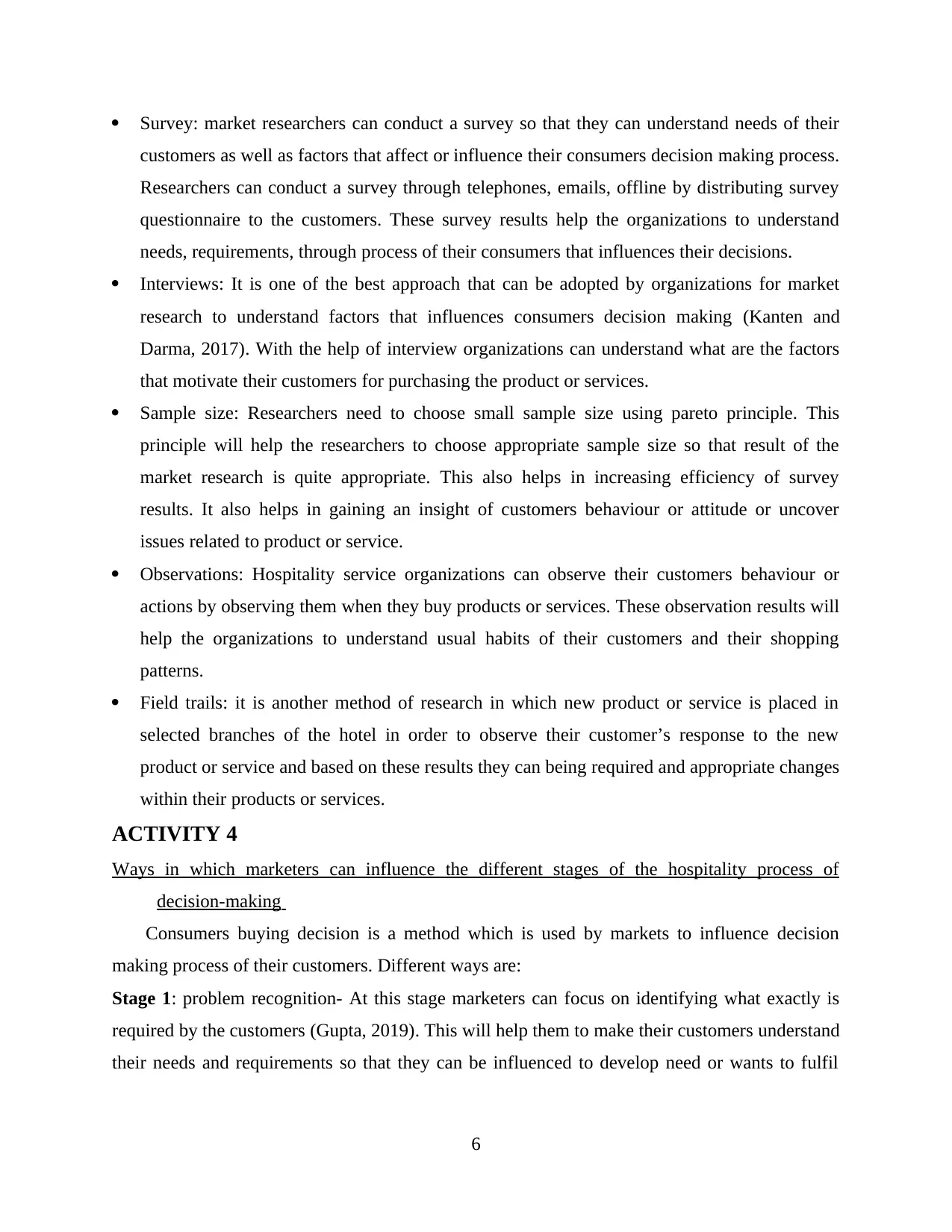
Survey: market researchers can conduct a survey so that they can understand needs of their
customers as well as factors that affect or influence their consumers decision making process.
Researchers can conduct a survey through telephones, emails, offline by distributing survey
questionnaire to the customers. These survey results help the organizations to understand
needs, requirements, through process of their consumers that influences their decisions.
Interviews: It is one of the best approach that can be adopted by organizations for market
research to understand factors that influences consumers decision making (Kanten and
Darma, 2017). With the help of interview organizations can understand what are the factors
that motivate their customers for purchasing the product or services.
Sample size: Researchers need to choose small sample size using pareto principle. This
principle will help the researchers to choose appropriate sample size so that result of the
market research is quite appropriate. This also helps in increasing efficiency of survey
results. It also helps in gaining an insight of customers behaviour or attitude or uncover
issues related to product or service.
Observations: Hospitality service organizations can observe their customers behaviour or
actions by observing them when they buy products or services. These observation results will
help the organizations to understand usual habits of their customers and their shopping
patterns.
Field trails: it is another method of research in which new product or service is placed in
selected branches of the hotel in order to observe their customer’s response to the new
product or service and based on these results they can being required and appropriate changes
within their products or services.
ACTIVITY 4
Ways in which marketers can influence the different stages of the hospitality process of
decision-making
Consumers buying decision is a method which is used by markets to influence decision
making process of their customers. Different ways are:
Stage 1: problem recognition- At this stage marketers can focus on identifying what exactly is
required by the customers (Gupta, 2019). This will help them to make their customers understand
their needs and requirements so that they can be influenced to develop need or wants to fulfil
6
customers as well as factors that affect or influence their consumers decision making process.
Researchers can conduct a survey through telephones, emails, offline by distributing survey
questionnaire to the customers. These survey results help the organizations to understand
needs, requirements, through process of their consumers that influences their decisions.
Interviews: It is one of the best approach that can be adopted by organizations for market
research to understand factors that influences consumers decision making (Kanten and
Darma, 2017). With the help of interview organizations can understand what are the factors
that motivate their customers for purchasing the product or services.
Sample size: Researchers need to choose small sample size using pareto principle. This
principle will help the researchers to choose appropriate sample size so that result of the
market research is quite appropriate. This also helps in increasing efficiency of survey
results. It also helps in gaining an insight of customers behaviour or attitude or uncover
issues related to product or service.
Observations: Hospitality service organizations can observe their customers behaviour or
actions by observing them when they buy products or services. These observation results will
help the organizations to understand usual habits of their customers and their shopping
patterns.
Field trails: it is another method of research in which new product or service is placed in
selected branches of the hotel in order to observe their customer’s response to the new
product or service and based on these results they can being required and appropriate changes
within their products or services.
ACTIVITY 4
Ways in which marketers can influence the different stages of the hospitality process of
decision-making
Consumers buying decision is a method which is used by markets to influence decision
making process of their customers. Different ways are:
Stage 1: problem recognition- At this stage marketers can focus on identifying what exactly is
required by the customers (Gupta, 2019). This will help them to make their customers understand
their needs and requirements so that they can be influenced to develop need or wants to fulfil
6
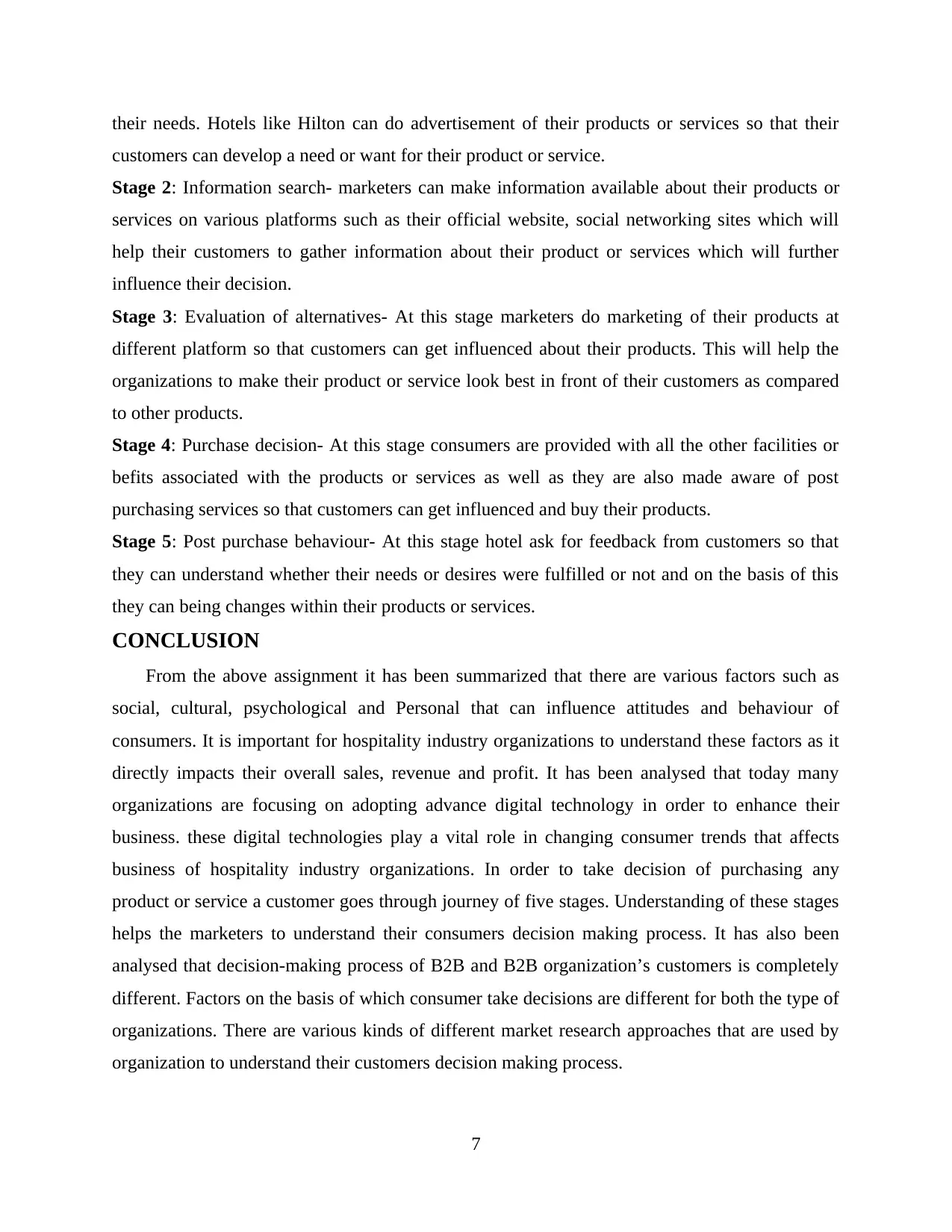
their needs. Hotels like Hilton can do advertisement of their products or services so that their
customers can develop a need or want for their product or service.
Stage 2: Information search- marketers can make information available about their products or
services on various platforms such as their official website, social networking sites which will
help their customers to gather information about their product or services which will further
influence their decision.
Stage 3: Evaluation of alternatives- At this stage marketers do marketing of their products at
different platform so that customers can get influenced about their products. This will help the
organizations to make their product or service look best in front of their customers as compared
to other products.
Stage 4: Purchase decision- At this stage consumers are provided with all the other facilities or
befits associated with the products or services as well as they are also made aware of post
purchasing services so that customers can get influenced and buy their products.
Stage 5: Post purchase behaviour- At this stage hotel ask for feedback from customers so that
they can understand whether their needs or desires were fulfilled or not and on the basis of this
they can being changes within their products or services.
CONCLUSION
From the above assignment it has been summarized that there are various factors such as
social, cultural, psychological and Personal that can influence attitudes and behaviour of
consumers. It is important for hospitality industry organizations to understand these factors as it
directly impacts their overall sales, revenue and profit. It has been analysed that today many
organizations are focusing on adopting advance digital technology in order to enhance their
business. these digital technologies play a vital role in changing consumer trends that affects
business of hospitality industry organizations. In order to take decision of purchasing any
product or service a customer goes through journey of five stages. Understanding of these stages
helps the marketers to understand their consumers decision making process. It has also been
analysed that decision-making process of B2B and B2B organization’s customers is completely
different. Factors on the basis of which consumer take decisions are different for both the type of
organizations. There are various kinds of different market research approaches that are used by
organization to understand their customers decision making process.
7
customers can develop a need or want for their product or service.
Stage 2: Information search- marketers can make information available about their products or
services on various platforms such as their official website, social networking sites which will
help their customers to gather information about their product or services which will further
influence their decision.
Stage 3: Evaluation of alternatives- At this stage marketers do marketing of their products at
different platform so that customers can get influenced about their products. This will help the
organizations to make their product or service look best in front of their customers as compared
to other products.
Stage 4: Purchase decision- At this stage consumers are provided with all the other facilities or
befits associated with the products or services as well as they are also made aware of post
purchasing services so that customers can get influenced and buy their products.
Stage 5: Post purchase behaviour- At this stage hotel ask for feedback from customers so that
they can understand whether their needs or desires were fulfilled or not and on the basis of this
they can being changes within their products or services.
CONCLUSION
From the above assignment it has been summarized that there are various factors such as
social, cultural, psychological and Personal that can influence attitudes and behaviour of
consumers. It is important for hospitality industry organizations to understand these factors as it
directly impacts their overall sales, revenue and profit. It has been analysed that today many
organizations are focusing on adopting advance digital technology in order to enhance their
business. these digital technologies play a vital role in changing consumer trends that affects
business of hospitality industry organizations. In order to take decision of purchasing any
product or service a customer goes through journey of five stages. Understanding of these stages
helps the marketers to understand their consumers decision making process. It has also been
analysed that decision-making process of B2B and B2B organization’s customers is completely
different. Factors on the basis of which consumer take decisions are different for both the type of
organizations. There are various kinds of different market research approaches that are used by
organization to understand their customers decision making process.
7
⊘ This is a preview!⊘
Do you want full access?
Subscribe today to unlock all pages.

Trusted by 1+ million students worldwide
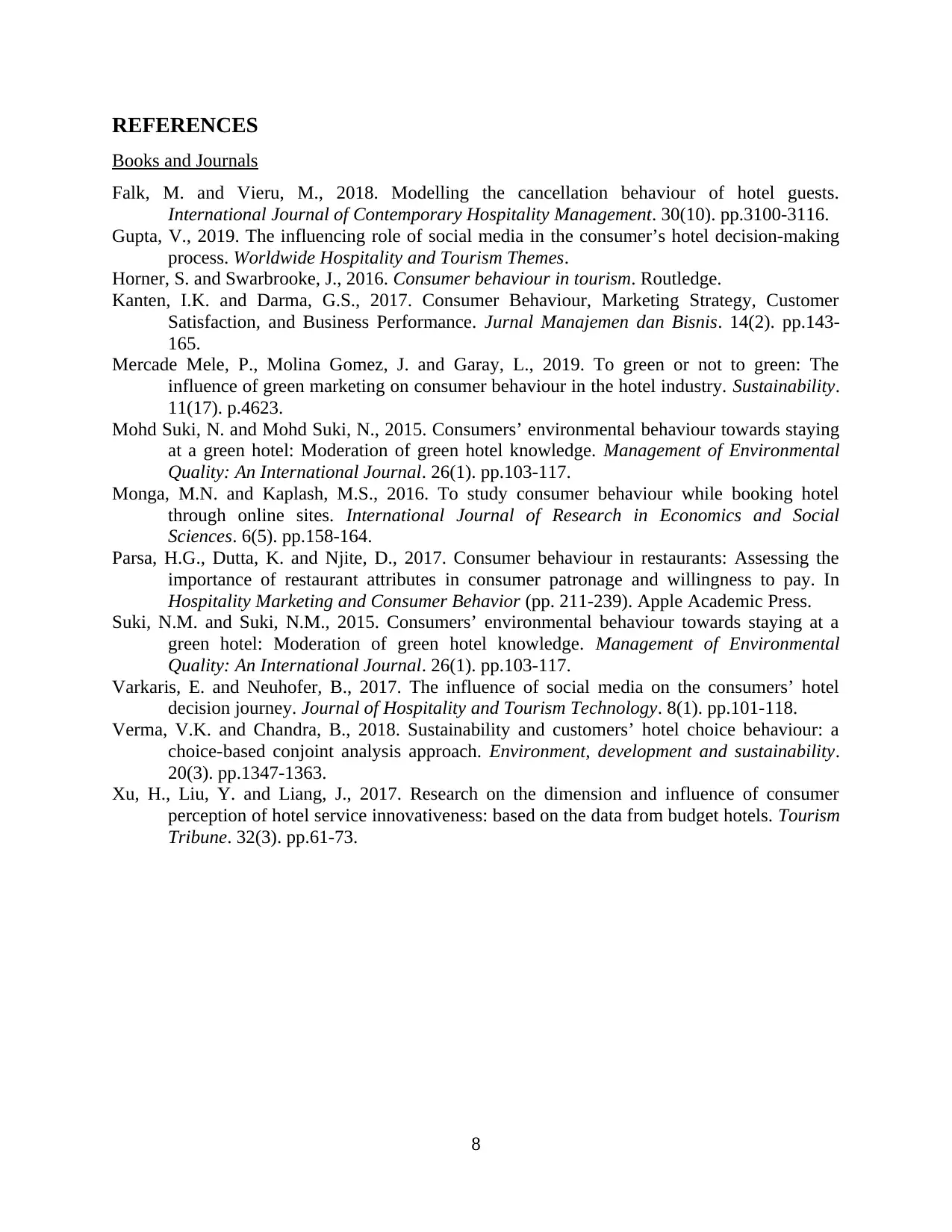
REFERENCES
Books and Journals
Falk, M. and Vieru, M., 2018. Modelling the cancellation behaviour of hotel guests.
International Journal of Contemporary Hospitality Management. 30(10). pp.3100-3116.
Gupta, V., 2019. The influencing role of social media in the consumer’s hotel decision-making
process. Worldwide Hospitality and Tourism Themes.
Horner, S. and Swarbrooke, J., 2016. Consumer behaviour in tourism. Routledge.
Kanten, I.K. and Darma, G.S., 2017. Consumer Behaviour, Marketing Strategy, Customer
Satisfaction, and Business Performance. Jurnal Manajemen dan Bisnis. 14(2). pp.143-
165.
Mercade Mele, P., Molina Gomez, J. and Garay, L., 2019. To green or not to green: The
influence of green marketing on consumer behaviour in the hotel industry. Sustainability.
11(17). p.4623.
Mohd Suki, N. and Mohd Suki, N., 2015. Consumers’ environmental behaviour towards staying
at a green hotel: Moderation of green hotel knowledge. Management of Environmental
Quality: An International Journal. 26(1). pp.103-117.
Monga, M.N. and Kaplash, M.S., 2016. To study consumer behaviour while booking hotel
through online sites. International Journal of Research in Economics and Social
Sciences. 6(5). pp.158-164.
Parsa, H.G., Dutta, K. and Njite, D., 2017. Consumer behaviour in restaurants: Assessing the
importance of restaurant attributes in consumer patronage and willingness to pay. In
Hospitality Marketing and Consumer Behavior (pp. 211-239). Apple Academic Press.
Suki, N.M. and Suki, N.M., 2015. Consumers’ environmental behaviour towards staying at a
green hotel: Moderation of green hotel knowledge. Management of Environmental
Quality: An International Journal. 26(1). pp.103-117.
Varkaris, E. and Neuhofer, B., 2017. The influence of social media on the consumers’ hotel
decision journey. Journal of Hospitality and Tourism Technology. 8(1). pp.101-118.
Verma, V.K. and Chandra, B., 2018. Sustainability and customers’ hotel choice behaviour: a
choice-based conjoint analysis approach. Environment, development and sustainability.
20(3). pp.1347-1363.
Xu, H., Liu, Y. and Liang, J., 2017. Research on the dimension and influence of consumer
perception of hotel service innovativeness: based on the data from budget hotels. Tourism
Tribune. 32(3). pp.61-73.
8
Books and Journals
Falk, M. and Vieru, M., 2018. Modelling the cancellation behaviour of hotel guests.
International Journal of Contemporary Hospitality Management. 30(10). pp.3100-3116.
Gupta, V., 2019. The influencing role of social media in the consumer’s hotel decision-making
process. Worldwide Hospitality and Tourism Themes.
Horner, S. and Swarbrooke, J., 2016. Consumer behaviour in tourism. Routledge.
Kanten, I.K. and Darma, G.S., 2017. Consumer Behaviour, Marketing Strategy, Customer
Satisfaction, and Business Performance. Jurnal Manajemen dan Bisnis. 14(2). pp.143-
165.
Mercade Mele, P., Molina Gomez, J. and Garay, L., 2019. To green or not to green: The
influence of green marketing on consumer behaviour in the hotel industry. Sustainability.
11(17). p.4623.
Mohd Suki, N. and Mohd Suki, N., 2015. Consumers’ environmental behaviour towards staying
at a green hotel: Moderation of green hotel knowledge. Management of Environmental
Quality: An International Journal. 26(1). pp.103-117.
Monga, M.N. and Kaplash, M.S., 2016. To study consumer behaviour while booking hotel
through online sites. International Journal of Research in Economics and Social
Sciences. 6(5). pp.158-164.
Parsa, H.G., Dutta, K. and Njite, D., 2017. Consumer behaviour in restaurants: Assessing the
importance of restaurant attributes in consumer patronage and willingness to pay. In
Hospitality Marketing and Consumer Behavior (pp. 211-239). Apple Academic Press.
Suki, N.M. and Suki, N.M., 2015. Consumers’ environmental behaviour towards staying at a
green hotel: Moderation of green hotel knowledge. Management of Environmental
Quality: An International Journal. 26(1). pp.103-117.
Varkaris, E. and Neuhofer, B., 2017. The influence of social media on the consumers’ hotel
decision journey. Journal of Hospitality and Tourism Technology. 8(1). pp.101-118.
Verma, V.K. and Chandra, B., 2018. Sustainability and customers’ hotel choice behaviour: a
choice-based conjoint analysis approach. Environment, development and sustainability.
20(3). pp.1347-1363.
Xu, H., Liu, Y. and Liang, J., 2017. Research on the dimension and influence of consumer
perception of hotel service innovativeness: based on the data from budget hotels. Tourism
Tribune. 32(3). pp.61-73.
8
1 out of 10
Related Documents
Your All-in-One AI-Powered Toolkit for Academic Success.
+13062052269
info@desklib.com
Available 24*7 on WhatsApp / Email
![[object Object]](/_next/static/media/star-bottom.7253800d.svg)
Unlock your academic potential
Copyright © 2020–2025 A2Z Services. All Rights Reserved. Developed and managed by ZUCOL.
